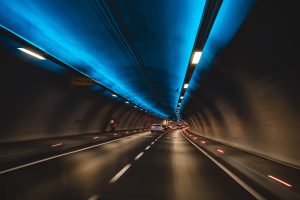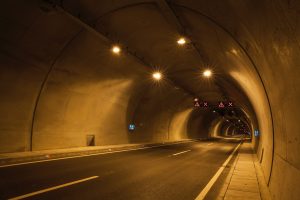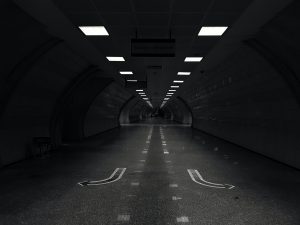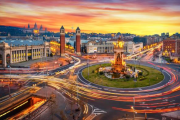Brief Description of Tunnel Lighting Design
1. Introduction
With the increasing number of tunnel projects, tunnel construction plays an increasingly important role in modern transportation. The tunnel is a closed space, and natural light cannot illuminate it. In order to ensure the continuity of driving and the safety of pedestrians, artificial lighting is required for the entire interior even during the day. Tunnel lighting is an indispensable part of tunnel construction.
Harsh environments such as automobile exhaust, noise, vibration, dirty air, corrosive gas, and moisture form the particularity of tunnel lighting. In order to provide a safe and comfortable lighting environment for passing vehicles and pedestrians, this article will explain the design ideas of tunnel lighting through step-by-step analysis.

2. Problems with vehicles passing through tunnels
2.1. Problems when approaching the tunnel
During the day, the eyes of motor vehicle drivers have adapted to the outdoor natural light illumination of more than 100,000 lx and thousands of cd/m2. When the eyes turn to the tunnel environment with a brightness of only a few cd/m2, due to the limited perception of the brightness difference by the human eye, the adaptation lag occurs. phenomenon, you will see a black cave, and you cannot recognize the state in it. The phenomenon of seeing a completely black cave in a bright environment like this is called a black hole phenomenon. Once the black hole phenomenon occurs, as the motor vehicle approaches the tunnel, the driver’s visual distance is shortened, and it is impossible to drive safely.
In order to prevent this from happening, the brightness at the entrance of the tunnel should be slowly reduced with the speed of visual adaptation, the brightness should be smoothly transitioned, and the brightness reduction should be carried out step by step, but the ratio of the brightness of the previous level to the brightness of the next level should not exceed 3:1, and the height should be 2m. The brightness of the following walls cannot be lower than the corresponding average road brightness.
2.2. Problems in passing through the tunnel
The brightness in the tunnel during the day is higher than that of the road lighting at night, and the brightness at night is lower than that in the daytime. Considering the exhaust gas emitted by cars in a long tunnel with large traffic flow, the exhaust gas cannot dissipate quickly to form smoke, absorb and scatter light, reduce visibility, and make visual recognition difficult. If necessary, the brightness of the road 100m ahead is halved, and the influence of exhaust gas is usually compensated for by twice the brightness of road lighting.
In addition, because the lights in the tunnel are arranged at a certain interval, the motor vehicle in front strongly reflects the light at a certain frequency, which makes people dazzling and uncomfortable. The installation interval of the lights should be determined according to the speed of the motor vehicle to avoid dazzling reflected light.
2.3. Problems when approaching tunnel exit
Looking through the exit, the exterior brightness is extremely high. The exit appears to be a bright hole, with severe glare, and the exit becomes a white cave, which is called the white cave phenomenon. With the white cave as the background, the motor vehicle, etc., becomes a black silhouette and is easy to identify. , but it is difficult to see the silhouette of the car and the large truck that follow behind the large box truck. Near the exit of the tunnel with heavy traffic flow, the lighting used to identify the overlapping vehicles is called exit lighting. The length of the illumination interval is several tens of meters.

3. Lighting design in the tunnel
3.1. Lighting method
The “Code for Design of Highway Tunnels” has formulated clear tunnel lighting standards, which stipulate lighting length, basic lighting, minimum road surface brightness, daytime lighting requirements and nighttime lighting brightness.
Tunnel lighting is generally divided into: general lighting, emergency lighting and special lighting.
General lighting includes the basic lighting necessary to ensure normal driving in the tunnel.
Emergency lighting generally uses a staggered arrangement of basic lighting fixtures, with two dedicated circuits each with one side of the power distribution method, supplemented by ordinary emergency lights when the illumination on one side is insufficient. In the selection of emergency power supply, there are centralized emergency power supply and decentralized emergency power supply schemes. Centralized emergency power supply devices generally include emergency power supply, uninterruptible power supply and generator. In long tunnels, the evacuation and induced lighting in case of sudden fire should be considered. This part of the lighting is mainly composed of ground indicator lights, wall lights, and evacuation indicator lights of separate lines.
Special lighting refers to the enhanced lighting and artificial landscape lighting that eliminates the “white hole” and “black hole” effects at the entrance and exit.
3.2. Lighting source
Tunnel lighting is required to be able to operate normally in an environment with poor relative air quality, low temperature and difficult light source replacement. The use of lights needs to consider the light distribution control in the direction of the cross-section of the road, so that the road and walls can achieve high-efficiency lighting at the same time.
The types of tunnel lighting sources include gas discharge light sources, LED light sources, and HID light sources. For lighting at the entrance and exit, HID light sources such as low-pressure sodium lights, high-pressure sodium lights, and metal halide lights are used. In basic lighting, the use of HID lights is gradually increasing. At present, gas discharge lights are commonly used in tunnels. Because LED and HID lights have significant effects on energy conservation and environmental protection, there is a trend to replace gas discharge light sources, but the actual lighting effect needs to be tested.
Combined with the actual situation of tunnel use, HID lights have the following advantages:
- The high-frequency electromagnetic induction coupling method excites the luminous light source, no filament and electrodes, super long life (more than 60,000 hours), fewer lightreplacement and maintenance times, and lower operating costs such as management fees and maintenance fees.
- The light efficiency is 65lm/W, the power factor is over 99%, which reduces reactive power consumption, saves more than 70% energy than high-pressure mercury lights and metal halide lights, and saves more than 50% energy than high-pressure sodium lights Is it reasonable to compare the light sources in this way).
- The color rendering index is greater than 80, the color rendering is good, the color temperature is optional from 2700K~6500K, the light color is soft, and the lighting clarity is improved.
- 2.65MHz high frequency start, no stroboscopic, protect eyesight.
- Using amalgam technology, no need to preheat, it will turn on immediately, start and restart instantly, and the number of switches can reach more than 200,000 times.
- High luminous flux maintenance rate and low light decay.
- The working temperature range is wide, and it can start and work normally within the range of -40℃~55℃.
- Arbitrary lighting position, shockproof, low surface temperature when the bulb is lit, and good explosion-proof performance.
Similarly, the advantages of high-power LED lights are also obvious:
- The light distribution is scientific and reasonable, meeting the lighting uniformity and anti-glare requirements of each section of the tunnel.
- Modular design of light source, each module can be installed and disassembled separately, maintenance is convenient and fast, and a series of costs are reduced.
- The series of products are rich in variety, which can meet the lighting requirements of the four sections of the tunnel’s entry section, transition section, basic section and exit section.
3.3. Lighting arrangement
Taking into account the road brightness, uniformity, glare, etc., the lights should be installed as high as possible, and easy to maintain and repair. lights are arranged on both sides of the tunnel at certain intervals.
In order to avoid the dazzling effect, take the installation interval of lights as S (unit: m) and the driving speed as V (unit: km/h), it should be S?V/54 or S?V/18.
The calculation of road brightness is the same as road lighting. If a computer is used, the illuminance increased by mutual reflection between the inner wall of the tunnel and the road can also be calculated. However, the specularity in the reflection characteristics of the road surface will affect its brightness, so it should be handled with caution.
In the layout of tunnel lighting, in addition to considering the brightness distribution, flash, induction, and easy maintenance of the lights should also be considered.
There are three main layout forms, namely relative arrangement, staggered arrangement and central arrangement. In order to avoid the unpleasant feeling of “flash” caused by the discontinuous direct light of the lights entering the cab from the side, try not to install the lights on the sides, but on the sides or the center of the top of the tunnel, and the installation height should be 4m above the road. The lighting fixtures are distributed linearly, and the brightness uniformity of the road surface should not be less than 0.35 under normal circumstances.

4. Conclusion
With the development of modern construction, the scale and quantity of tunnel lighting facilities will become larger and larger.
Tunnels are places with high energy consumption, and the cost of electricity operation is getting higher and higher. There will be more urgent needs for high-efficiency energy-saving light sources, lighting energy-saving control systems, and reasonable brightness design to improve lighting effects and ensure driving safety and comfort.



